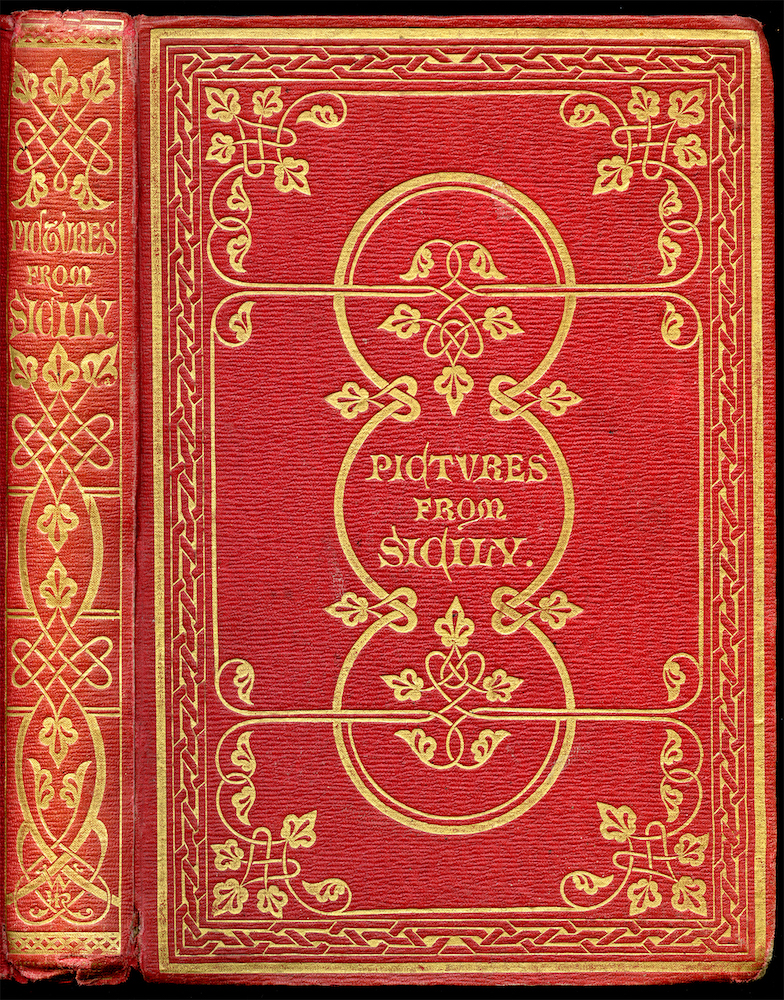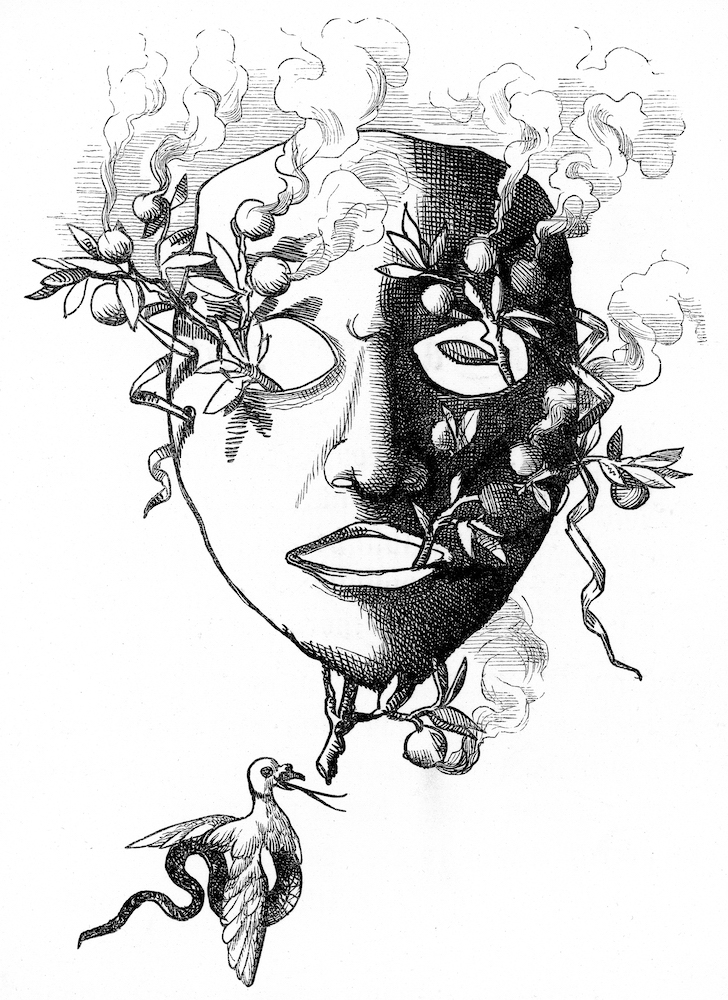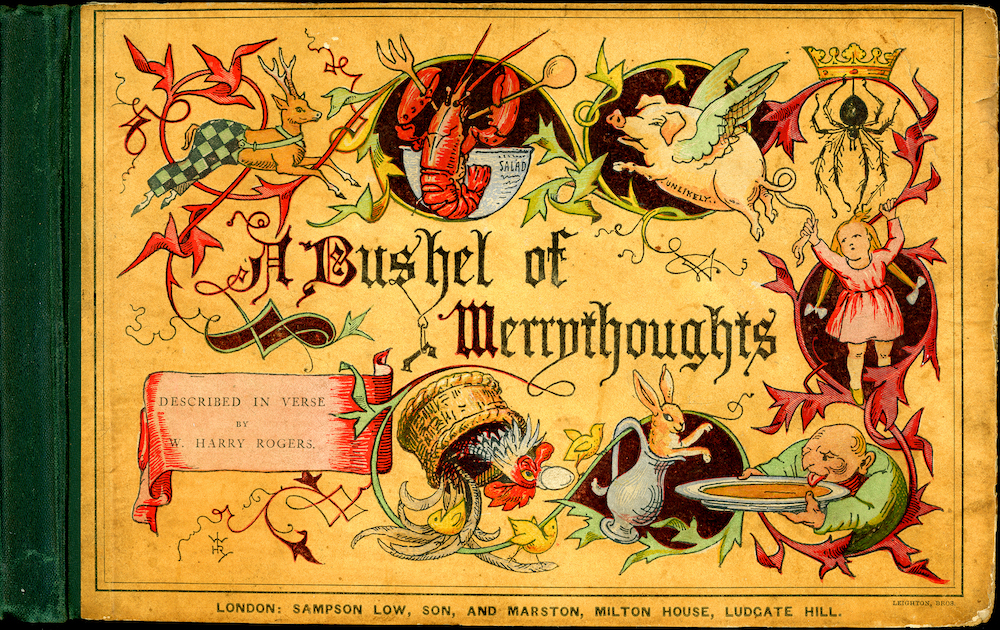
This is the first major study of William Harry Rogers, who was one of the finest of the Victorian decorative book cover designers, but who also worked in other areas including wood carving, silver and jewellery. The author has spent many years on this project and the result is this substantial volume which deals in fine style with every aspect of Rogers’s life and work.
Rogers (1825–1873) spent his early years in London where he became entranced with the carvings of Grinling Gibbons, who was to prove a major influence on the young designer. Every decade of his life is covered in extensive detail. In 1847 he married Mary Ann Lansdale and for their wedding Rogers designed a double glass-sided brooch, a touching and highly personal item which provides an early insight into his decorative designs. A close friend and fellow designer was George Isaacs with whom he made a trip to Paris. Both lived there for six months in 1844. With Isaacs he produced several articles on art history for a short-lived periodical Hesperus, which ran for just five issues from September 1843. On subjects such as the fleur-de-lys, these articles foreshadow other learned pieces, notably in the Art Journal and the Builder in later years. By 1850 there was a cooling of relations between the two designers, and this was never repaired.

Pictures from Sicily (London: Hall, 1853), cover designed by Rogers. Image © Gregory Jones.
An entire chapter is devoted to the two signatures which Rogers employed. The one he used chiefly was his three initials, and is found on almost all his book covers. Between 1840 and 1847 however he used an alternative, recorded here as ‘H/RWR,’ and looking for this enabled the author to identify a number of designs not noted until now. In all, some 244 book cover designs are recorded, a far larger number than were identified by earlier writers; these are listed in a section called a Gallery, an appendix where all are described, together with superb colour images.
Rogers was heavily involved with both the Builder and the Art Journal from the early 1840s until the late 1870s. He contributed not only articles on design but also artistic designs of his own. Through the Builder, he became linked with an idealistic group of architects and artists founded by Alfred Bartholomew. Several chapters are devoted to these two periodicals, and there is much here that is new and ground-breaking. The various fields for which Rogers made designs are covered with informed sections on silver including cutlery and jewellery, and again the reader is indebted to the author for providing so much that is novel. In the 1840s and 1850s Rogers launched attacks on the designer Henry Cole, whom he saw as a bitter rival and as someone who produced inferior designs with his much-vaunted Felix Summerly design operation.

Hypocrisy an emblematic design from Spiritual Conceits (London: Nisbet, 1862), designed by Rogers. Image © Gregory Jones
For the Great Exhibition of 1851 Rogers submitted a number of designs, and especially to be noted was Queen Victoria’s cradle made of boxwood. When it was shown at the Exhibition she remarked that ‘The Fine Arts Court, containing wood carving, of every kind and sort was most beautiful. Amongst it was our beautiful cradle.’ The design of the cradle had been arrived at in consultation with Victoria and Prince Albert, and had taken many years to carve on account of the extreme hardness of the wood. In his silverware designs, he was noted for the Renaissance influence which played so much a part in his work, derived in part from Gibbons whose imagery Rogers took on board in almost all his objects. Rogers received several prize medals awarded at the Exhibition for his designs which were numbered in double figures. Five Art Journal catalogues were devoted to the subject, and Rogers’s work was remarked upon in some detail. He contributed most of the beautiful designs featured in them, and Jones points out that he ‘Lit up the Great Exhibition.’ His fine designs were praised in the Art Journal catalogue volume as ‘outstandingly creative artistic enhancements' that 'made it by far the most vivid printed record of the exhibition.’

Boxwood Rocking Cradle for Princess Louise, designed by William Harry Rogers and carved by William Gibbs Rogers, his father (1850), and exhibited at the Great Exhibition.
.While Rogers is noted for the book designs for which he produced covers and decorations, such as chapter headings and initial lettering, there is one book where he uniquely designed both the cover and the contents. This is Spiritual Conceits of 1861 (London: James Nisbet and Co); here he produced some one hundred concepts which were placed in eight categories. The volume was received with general approbation by the critics and he was praised by the Morning Post) where it was remarked ‘the selections have been made by Mr Rogers … and the illustrations are from the graceful hand of Mr Rogers himself, and leave one in doubt which most highly to estimate – the fertility of his imagination, or the facility of his execution.’ The book was a triumph in every way, but it was not noted by later critics of illustration because its designs were essentially decorative rather than figurative or descriptive. Jones has shown here just how worthy it is to be considered outstanding as a work of art.

Another binding design by Rogers, A Bushel of Merry Thoughts (London: Sampson Low, 1868), introducing Wilhelm Busch‘s picture-stories. Image © Gregory Jones.
There are several books for which Rogers made decorations, including a title-page design for The Children’s Pilgrim’s Progress (Bell and Daldy, 1860) and Quarles’ Emblems. Illustrated by Charles Bennett and W. Harry Rogers (James Nisbet, 1861). On each page Rogers drew the outer decoration, and Bennett the inner for the eighty images. In the 1870s Rogers made decorative designs for playing cards and these make up a small but not insignificant part of his oeuvre. Similar are his designs for jewellery which he provided for a large store in Regent Street, Howell and James. These decorations were shown in the London 1872 Exhibition together with other designs by fellow designers, notably John Leighton and Charles Eastlake, to name but two. Rogers also produced designs for marriage lockets and bridal lockets; one of the marriage lockets was made up of fairy marriage bells ringing from a spray of orange blossoms. All this shows the breadth of Rogers’s imagination and his skills in so many fields, and most of these are illustrated.
Perhaps unsurprising is the extensive section devoted to the book covers themselves, which are all illustrated in colour with full descriptions. These reveal the remarkable variety which Rogers brought to everything he did. While the books were within reach by almost anyone, items such as jewellery and silverware could only be afforded by the wealthy.
In summing up, what can one say about the art of William Harry Rogers? The range and excellence of the work is shown here and all is done with erudition while remaining eminently readable. Indeed, it is fair to say that this elegant volume provides full coverage of a supreme artist and establishes Rogers as a genuine master of Victorian design. It is the first and surely wil be the last to deal with Rogers in this way, and leaves no aspects neglected.
Book under Review
Rogers, William Harry, Victorian Book Designer and Star of the Great Exhibition. Norwich: Unicorn 2023. £50.00.
Created 10 April 2023